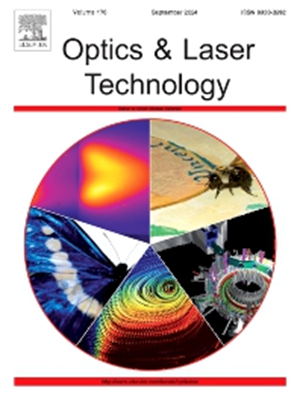High-precision etching of micro-grooves within double-layer glass via liquid-assisted laser ablation
IF 4.6
2区 物理与天体物理
Q1 OPTICS
引用次数: 0
Abstract
Glass is a highly transparent and chemically stable material with considerable application potential. However, its high hardness and brittleness pose challenges in processing, particularly when creating intricate 2D and 3D microstructures. Traditional processing methods often result in lower precision and poor edge quality. Recent advancements in laser technology, particularly with femtosecond lasers, offer new solutions due to their minimal thermal impact and ability for high-quality cold processing. This paper introduced a novel liquid-assisted laser ablation method, compared the ablation effects of different pulse-width laser sources and achieved single-step etching of double-layer glass. By encapsulating copper sulfate (CuSO4) solution as an absorbent within the double-layer glass, high-precision micro-grooves were successfully etched. The results indicated that micro-groove depth can be controlled by adjusting laser parameters, with femtosecond laser outperforming nanosecond laser in etching quality. This study also delved into the underlying principles, revealing the mechanisms of material modification during femtosecond laser ablation. Furthermore, laser-induced plasma-assisted penetration (LIPAP) technique allowed for filling the micro-grooves with copper paste, in order to create stable surface heating circuits and verify the functionality. This laser double-layer processing strategy offers an effective solution for the precise fabrication of micro-functional devices based on transparent hard and brittle materials.
求助全文
约1分钟内获得全文
求助全文
来源期刊
CiteScore
8.50
自引率
10.00%
发文量
1060
审稿时长
3.4 months
期刊介绍:
Optics & Laser Technology aims to provide a vehicle for the publication of a broad range of high quality research and review papers in those fields of scientific and engineering research appertaining to the development and application of the technology of optics and lasers. Papers describing original work in these areas are submitted to rigorous refereeing prior to acceptance for publication.
The scope of Optics & Laser Technology encompasses, but is not restricted to, the following areas:
•development in all types of lasers
•developments in optoelectronic devices and photonics
•developments in new photonics and optical concepts
•developments in conventional optics, optical instruments and components
•techniques of optical metrology, including interferometry and optical fibre sensors
•LIDAR and other non-contact optical measurement techniques, including optical methods in heat and fluid flow
•applications of lasers to materials processing, optical NDT display (including holography) and optical communication
•research and development in the field of laser safety including studies of hazards resulting from the applications of lasers (laser safety, hazards of laser fume)
•developments in optical computing and optical information processing
•developments in new optical materials
•developments in new optical characterization methods and techniques
•developments in quantum optics
•developments in light assisted micro and nanofabrication methods and techniques
•developments in nanophotonics and biophotonics
•developments in imaging processing and systems

 求助内容:
求助内容: 应助结果提醒方式:
应助结果提醒方式:


